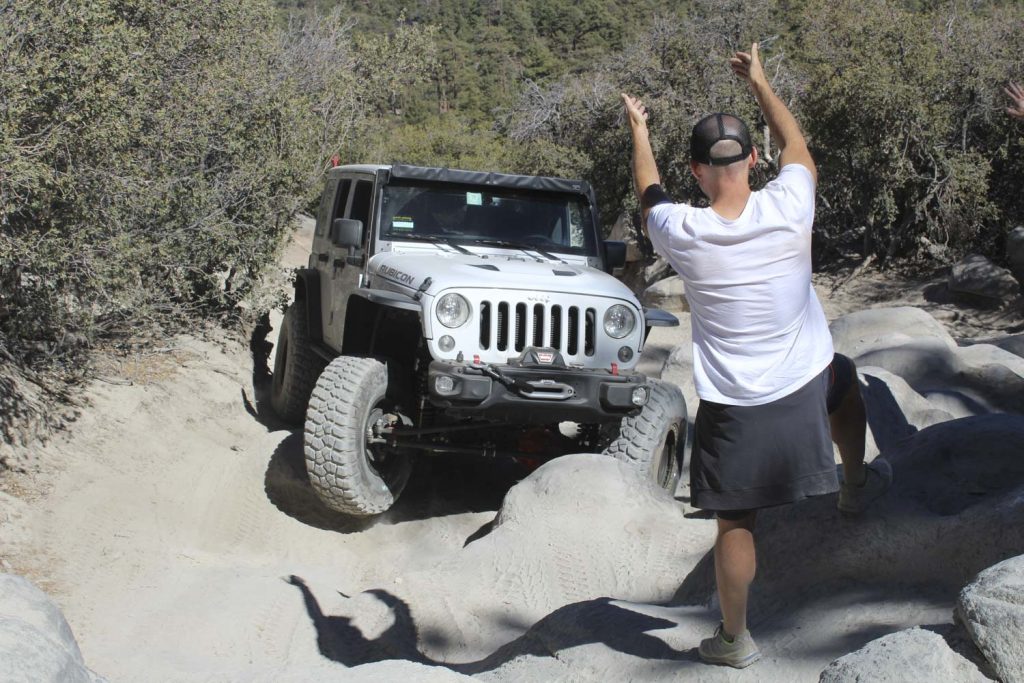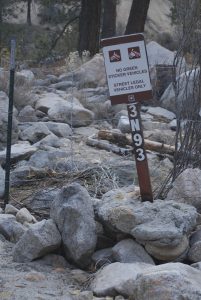Community, Event Coverage, Land Use, Tech
Top Tips for 4×4 Newcomers
Top Tips for 4×4 Newcomers
Tips and photos from Don Alexander
Are you new to off-road? Sometimes joining the club can be a little daunting. The environment is very different compared to driving on the highway. There’s often a fear of getting lost or stuck, and that keeps many newcomers from experiencing all the adventures that four wheeling offers.
There’s much to learn, but none of it is insurmountable. The tips we’re sharing were developed for first-time students at the Jeep 4×4 School in Big Bear Lake, California.

#1 – Learn your vehicle. Knowing your vehicle and its controls is paramount to being comfortable in the driver’s seat. Pay particular attention to the transfer case. Start by reading the owner’s manual – then go out to your vehicle and practice. Shift everything as it instructs and back again. Do it a second time. Then when given the opportunity, find a dirt road and do it again.
#2 – Visual fiends. Where do you look when you drive? In off-road, taking in the terrain as far in front of you as possible is important, include the terrain to the sides and rear. Keep your eyes moving in anticipation of the terrain. Picking your line matters.
#3 – Pay attention. Inattention, for even just a split second, can create a situation that’s difficult to recover from.
#4 – Hands on the wheel. As the driver, your hands are on the top of the steering Thumbs on top of the rim, not wrapped around the wheel. Injuries can occur to wrists and thumbs from steering wheel kick-back.
#5 – Place tires for Ground Clearance – this is another practiced trait . Practice on small rocks and see how your tire placement creates appropriate ground clearance. Clearance will protect your vehicle. If in doubt, reduce speed while you practice.
. Practice on small rocks and see how your tire placement creates appropriate ground clearance. Clearance will protect your vehicle. If in doubt, reduce speed while you practice.
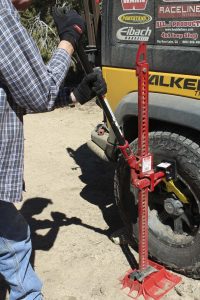 #6 – Adjust your tire pressure. Tires are aired down to improve traction by expanding the contact patch of the tire (the amount of the tire that touches the ground.), it also softens the ride and reduces the risk of a puncture. The optimum air pressure varies by vehicle. Don’t go below 12 PSI without beadlock wheels.
#6 – Adjust your tire pressure. Tires are aired down to improve traction by expanding the contact patch of the tire (the amount of the tire that touches the ground.), it also softens the ride and reduces the risk of a puncture. The optimum air pressure varies by vehicle. Don’t go below 12 PSI without beadlock wheels.
#7 – Disconnect Sway bars. Sway bars limit body roll on the the highway, that provides a safer ride. Off-road, you need more movement, because your speeds are lower, you can afford more roll. Disconnecting sway bars reduces the likelihood of tires lifting off the ground.
#8 – Use a spotter. A spotter is a sound idea, a spotter is the driver’s eyes outside the vehicle. They can provide clear direction on how to tackle an obstacle, tire placement and such.
#9 – Learn basic navigation. GPS provides valuable information for off-road navigation, but electronics can fail. Always carry a paper map and learn how to read it.
#10 – Travel in Groups or file a flight plan. It is prudent to travel in groups, to have additional resources should something go wrong. It’s ok to get instruction. Join a club run, sign up for a professional event, join a class – all are great ways to learn the ropes. If you are hell-bent on going solo, tell someone about your route, and then follow it, so if you don’t return on time, there is a plan to look for you. Consider carrying a satellite locator that can act as an emergency beacon.
#11 – Carry Recovery Gear. Best to be prepared, ever the most experienced driver will encounter trouble on the trail. Carry a tow strap and shackles, at the very least. Others on the trail may be willing to help, but they are more likely to stop if you look like you are ready to help yourself.
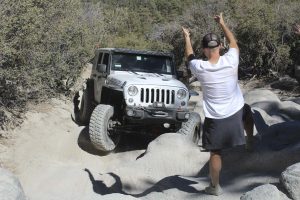
#14 – Be prepared. That goes without saying, but it’s more than having your vehicle prepared. It’s preparing yourself as well. Carry water and snacks. Even if you just plan a short excursion, it’s best to carry more than you need, then less. Water is about survival. Bring layers of clothing, a 90 degree day in the desert can make for a cold night to follow. Carry blankets, emergency supplies, rain ponchos. Be prepared for a change in the weather. Comfort items are nice too, maybe those folding camp chairs, hand wipes, paper towels. Toilet paper. Exploring off-pavement shouldn’t lack civilization.
#15 – First Aid kit. A basic first aid kit should always be in your rig. On or off trail. If you really want to be prepared, take a class, learn more about back-country first aid, it could be of great benefit for you and your trail mates. Don’t forget your medications.
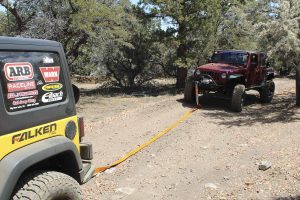 #16 – Know the code. That means stay on designated routes. If you can’t stay on the trail, don’t go out at all. Legal routes only, the biggest threat to motorized vehicle access on public lands is travel on illegal routes. We can’t afford to have rookies – or anyone else – making new trails.
#16 – Know the code. That means stay on designated routes. If you can’t stay on the trail, don’t go out at all. Legal routes only, the biggest threat to motorized vehicle access on public lands is travel on illegal routes. We can’t afford to have rookies – or anyone else – making new trails.
#17 – Pack it in, pack it out. If you had room to bring it, you have room to take it home with you. Trash is a huge threat to our environment. Just take it back home with you and dispose of it there where it’s easy. Don’t make it someone else’s problem.
#18 – Angle through Ruts. Getting high-centered on bumps and ruts is both annoying and embarrassing, you can minimize your risk by crossing bumps and ruts at an angle. Maximize your ground clearance by placing one tire at a time over the bump or through the rut.
#19 – Use the right gear. No four wheel drive necessary on pavement. Switch to high range four wheel drive when you get on dirt for improved control. When climbing or descending hills, consider low range, but remember to keep your speeds slow. RPM no more than 3000, if you exceed that in low range, switch back to high.
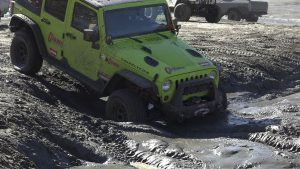 #20 – Speed for hill climbs. Keep wheelspin to a minimum by climbing at 3 to 5 MPH. Know what is at the top of a climb, even if you have to hike it to find out. Many climbs require a sharp turn as the hill is crested, carrying too much speed can lead to an uncomfortable and dangerous ride.
#20 – Speed for hill climbs. Keep wheelspin to a minimum by climbing at 3 to 5 MPH. Know what is at the top of a climb, even if you have to hike it to find out. Many climbs require a sharp turn as the hill is crested, carrying too much speed can lead to an uncomfortable and dangerous ride.
#21 – Braking downhill. Relying only on brakes as you descend a steep hill can be uncomfortable. Consider using your low gearing to help you control your speed, you don’t want the weight to lift off your rear tires during the descent. Gentle acceleration can put more weight on the rear end, but keep it controlled.
#22 – Dropping down ledges. Hard braking is required when dropping down ledges or off rocks. The tires should roll slowly, no bounce. If it feels too fast, it probably is, stop and bump it gently then hard brake. Turning uphill can have an unexpected result, steer downhill or towards the lower tire to reduce the risk of a rollover.
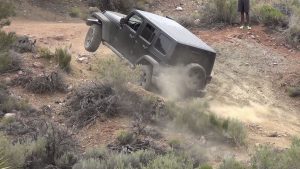
#23 – More Recovery Gear. You’ve already got the strap and shackles, let’s add to that list. A shovel, Hi-Lift jack, winch, MaxTrax, PullPal, Deadman – any and all of the above might be necessary if you’re really stuck. It all depends on your terrain. Take what makes sense.
#24 – Steering. Off-roading often requires full lock steering maneuvers in tight quarters. Turn too soon, you’ve got body damage. The rear tires do not follow the tracks of the front tires, they will track inside of them. The sharper the turn, the more pronounced this becomes. Short wheelbast vehicles should begin turning when the obstacle is at the A pillar; longer wheelbase vehicles should use the B pillar for their marker.
#25 – Off-roading is not a competition. Everyone is out there for their own reason, some to enjoy the beauty, some to explore, some to enjoy the solitude, others for the camaraderie. Whatever reason brought you here, know that you are welcome, you will make mistakes, but you will also make friends. Relax and have fun.

